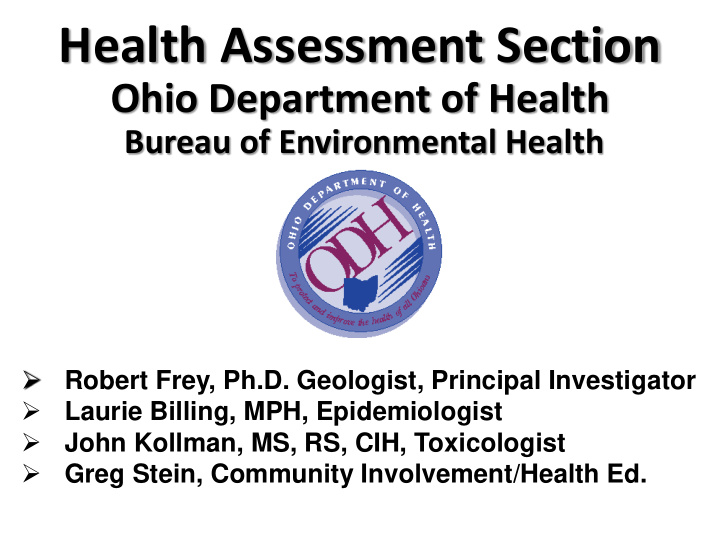



Health Assessment Section Ohio Department of Health Bureau of Environmental Health Robert Frey, Ph.D. Geologist, Principal Investigator Laurie Billing, MPH, Epidemiologist John Kollman, MS, RS, CIH, Toxicologist Greg Stein, Community Involvement/Health Ed.
ODH / ATSDR Cooperative Agreement Program Federal grant $$ cover staff salary and training. The mission of the partnership is to protect the public health of the people of Ohio through: Evaluating chemical levels in environmental media across the state in order to identify potential exposure to toxic chemicals through contact with contaminated water, air, soil and the food chain (fish).
What is the Agency for Toxic Substances and Disease Registry (ATSDR)? The ATSDR is a sister agency of the CDC ATSDR is the principal federal public health agency involved with hazardous waste and human health issues. ATSDR’s headquarters are in Atlanta, GA , with 10 regional offices throughout the nation. Ohio is in Region V, Chicago .
HAS works closely with ATSDR, the U.S. EPA, Ohio EPA, local health districts and concerned communities at hazardous waste sites throughout Ohio.
ODH was contacted by ODOT in July of 2012. We were asked to look at the available data in order to determine if there was a public health hazard posed to the residents that lived around ODOT’s Former Garage Site. In order for ODH to determine if there is public health threat, we needed to determine if people were coming into contact with site related chemicals. As people were not drinking TCE- contaminated water, our main concern focused on the vapor intrusion threat.
Site Chemical of Concern: TCE What is TCE? TCE is a man-made chemical that is not naturally found in the environment. It is mainly used as a cleaner in industry to remove grease from metal parts. TCE can also be found in common household items such as glues, paint removers, typewriter correction fluids and spot removers.
TCE (continued) How does TCE affect your health? Breathing (Inhalation): Breathing high levels of TCE may cause headaches, lung irritation, dizziness, poor coordination (clumsy) and difficulty concentrating. Breathing very high levels of TCE for long periods may cause nerve, kidney and liver damage. Drinking (Ingestion): Drinking high concentrations of TCE in the water for long periods may cause liver and kidney damage, harm the immune system and damage fetal heart development in pregnant women. Skin (Dermal) Contact: Short periods of skin contact with high levels of TCE may cause skin irritation and rash. Does TCE cause cancer? In September of 2011 the U.S. EPA revised their Integrated Risk Information System (IRIS) numbers for cancer and non-cancer effects for Trichloroethylene (TCE). The U.S. EPA newly revised IRIS document has classified TCE as “carcinogenic to humans.” Cancer Studies in Humans found that occupational exposure to TCE was associated with excess incidences of liver cancer, kidney cancer, non-Hodgkin’s lymphoma, prostate cancer, and multiple myeloma, with the strongest evidence for the first three types of cancer.
What is Vapor Intrusion? connecting the dots Groundwater Contamination Chemical Spill-TCE groundwater flow TCE Contaminated Groundwater = 144 ppb
What is Vapor Intrusion? Soil gas Contamination Chemical Spill-TCE TCE Soil Gas Vapors = groundwater flow 610 ppb/v TCE Contaminated Groundwater = 144 ppb
What is Vapor Intrusion? Sub-slab Contamination Sub-slab Chemical Spill-TCE TCE Soil Gas Vapors = 610 ppb/v TCE Contaminated Groundwater = 144 ppb
Sub-Slab Sampling
What is Vapor Intrusion? Indoor Air Contamination Indoor Air Sampling 4.7 ppb/v Sub-Slab sampling Chemical Spill-TCE TCE Soil Gas vapors TCE Contaminated Groundwater
Indoor Air Sampling
What is Vapor Intrusion? Indoor Air Sampling Sub-Slab sampling Chemical Spill-TCE TCE Soil Gas vapors TCE Contaminated Groundwater Groundwater Contamination + Soil gas Contamination + Sub slab Contamination + Indoor Air Contamination = Completed Exposure Pathway
Vapor Intrusion Mitigation Demonstrate a completed vapor intrusion pathway and An exceedance of ODH/ATSDR indoor air screening levels Vapor Intrusion Mitigation of Home or Structure (Short-term) = installation and operation of a sub-slab vapor abatement/depressurization system -- aka Radon system. (Long-term) = Source identification, mitigation and/or removal.
Health Assessment Section Ohio Department of Health Bureau of Environmental Health Ohio Department of Health Bureau of Environmental Health Health Assessment Section 246 N. High Street Columbus, Ohio 43215 Phone: (614) 466-1390 Fax: (614) 466-4556 Web: http://www.odh.ohio.gov/odhprograms/eh/hlth_as/HAS.aspx
Recommend
More recommend